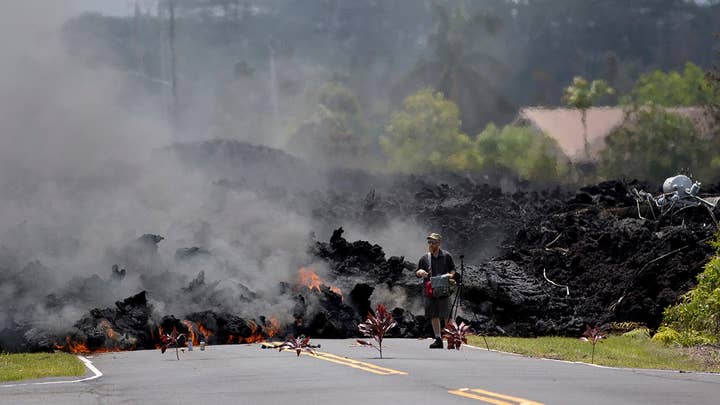Hawaii's Kilauea volcano in danger of turning explosive
Scientists warn of once-in-a-century eruption from Hawaii's Kilauea volcano, stating it could explode within a week; Jonathan Hunt has the latest.
Hawaii County Civil Defense officials on Friday widened the radius of their warnings as volcanic instability on the Big Island roared on.
Also on Friday, Hawaii Gov. David Ige said President Donald Trump had approved his request for a federal disaster declaration for the area affected by the eruption of the Kilauea volcano. The move helps make federal assistance available to Hawaii as works to repair roads, parks, schools and infrastructure affected by the disaster.
Authorities urged residents in lower Puna to remain vigilant and alert in the event of a possible gas emission and volcanic eruption of Kilauea.
“Because there may be little to no advance notice to evacuate, you should be prepared to evacuate at short notice,” authorities said. “Take this time to prepare.”
Residents who want to voluntarily leave can take shelter at the Pahoa Community Center and Kea’au Community Center. Both are pet-friendly.

Lava from Fissure 7 slowly advances to the northeast on Hookapu Street in the Leilani Estates subdivision in Pahoa, Hawaii, May 5, 2018. (U.S. Geological Survey via Associated Press)
Authorities on Friday also shut down all beach parks in Lower Puna.
But local tourism officials stressed that other parts of the Big Island and the state remained open, in a bid to ease vacationers’ concerns.
"We know what people are going through in Leilani Estates. And we don't want to seem callous and inconsiderate in our messaging and our promotion of the island," said Ross Birch, executive director of the Island of Hawaii Visitors Bureau.
At the same time, he said, tourism is the island's biggest industry and people's livelihoods are dependent on visitors coming.
"We want to make sure that everybody is still working and people have jobs to go back to," Birch said.
Kilauea has destroyed at least 36 structures — including 26 homes — since May 3, when it began releasing lava from vents about 25 miles east of the summit crater. Fifteen of the vents are now spread through the Leilani Estates and Lanipuna Gardens neighborhoods.
About 2,000 people have been evacuated from the neighborhoods, where scorching lava has oozed from the ground.
The volcano, which has been spitting and sputtering lava for a week, has also imperiled a geothermal energy plant, the Puna Geothermal Venture plant.
Gov. Ige said crews at the plant near the lava outbreak accelerated the removal of stored flammable fuel with safety in mind.
Geologists warned Wednesday that Kilauea could soon experience explosive eruptions from its summit, and launch “ballistic” rocks and ash into the air.
The next explosion could hurl ash and boulders the size of refrigerators miles skyward, shutting down airline traffic and endangering lives in all directions.
“If it goes up, it will come down,” said Charles Mandeville, volcano hazards coordinator for the U.S. Geological Survey. “You don’t want to be underneath anything that weighs 10 tons when it’s coming out at 120 mph.”
The added threat of an explosive eruption could ground planes at one of the Big Island’s two major airports and pose other dangers. Officials with the national park around the volcano announced that it would close because of the risks.
“We know the volcano is capable of doing this,” said Mandeville, citing similar explosions at Kilauea in 1925, 1790 and four other times in the last few thousand years. “We know it is a distinct possibility.”
The threat of explosive activity will rise as lava drains from the summit of Kilauea and explosions will be possible in the coming weeks if the lava dips below the groundwater table, the U.S. Geological Survey (USGS) said.
If lava drops below the groundwater level, it can heat up the water and create steam.
The steam would then build in pressure as rocks fall and form a dam within the volcano’s walls, and ”cause steam-driven explosions” with “very little warning,” according to the Hawaii Volcano Observatory.
A similar 1924 explosion threw pulverized rock, ash and steam as high as 5.4 miles into the sky, for a couple of weeks. If another blast happens, the danger zone could extend about three miles around the summit, land all inside the national park, Mandeville said.
Fox News’ Frank Miles, Stephen Sorace and the Associated Press, contributed to this report.


